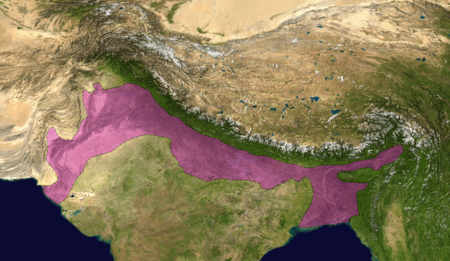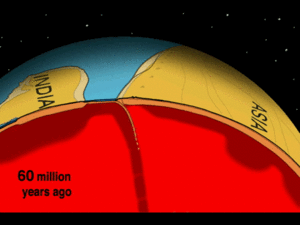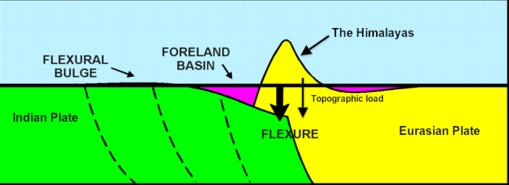Himalayan foreland basin

The Himalayan foreland basin is an active collisional foreland basin system that developed adjacent to the Himalayan mountain belt in response to the weight of crustal thickening when the Indian Plate collided and subducted under the Eurasian plate. With a width of 450 kilometres (280 mi) and 2,000 kilometres (1,200 mi) long,[1] the foreland basin span to five countries which include: India, Nepal, Pakistan, Bhutan, and Bangladesh. Sedimentary rock records gathered on the greater Himalayan area surrounding India and Nepal traces back to the onset development of the foreland basin which started at the Paleogene period around 45-50 Ma to the time where India and Asia collided.[2] A debate has arise that the basin exhibits the concept of progressive suturing (diachroneity) which means a lag in time exists between parts of the basin; it was inferred the development of the western part of basin started at the Paleocene period around 57-54 Ma with the central part having 2 Ma in difference, and gets younger as it progresses towards the eastern side.[3] The various stratigraphic succession of the basin is important as it preserves the evidence of the India-Eurasia collision as well as relating it to the Himalayan Orogenesis.
Geologic setting
During the Late Cretaceous, the northward drifting Indian plate covered a great distance during the closure of the Neo-Tethys Ocean when India finally collided with the Eurasian plate. Both continental plates are relatively low density and cannot be subducted, resulting in the Eurasian plate (Tibetan Plateau) being thrusted up and the subsequent development of the Himalayan mountain range to the south. The foreland basin is adjacent to the Himalayan mountain belt and is bordered by the Indian Craton on the South, the Tibetan Plateau on the north and is located south of the Indus-Yarlung suture zone. The foreland basin much like the Himalayan mountain range, span approximately 2,000 kilometres (1,200 mi) west to east across India, Nepal, Bhutan and Bangladesh. The present day foreland basin is now widely known as the Indo-Gangetic plain which is mostly "U" and wedge shaped, and sits mostly on the Indian Craton.
Stratigraphy
The importance of stratigraphy on the Himalayan foreland basin is unparalleled due to its significance on unlocking the development of the basin throughout the Geologic time. The three main formations that indicates the main evolution of the foreland basin is the Subathu marine formation, the Dagshai continental formation which is exposed in various locations although most analysis is done in Jammu, and the Siwalik group which consists of the Lower, Middle, and Upper Siwalik group.

Subathu
The Subathu Formation is the oldest foreland basin deposits and overlies a rigid precambrian basement of the entire foreland basin system that consisted of dolomitic limestone, chert, and calcareous shale. The Subathu Formation mainly composing of marine to shallow marine facies in the form of shales and minor amounts of sand also consists of predominantly green mudstone with minor red facies and were dated back to the upper paleocene to lower mid eocene period based on the existence of Nummulites gathered from biostratigraphical data. petrographic interpretation of the green Subathu Formation were shown to be predominantly sedimentary with minor traces of serpentine schist input. Although the red facies shows a more felsitic and of volcanic origins, it entails that it originates from continental flood basalts of the Indian craton. The Subathu Formation was interpreted to be a preservation of the intense collision between the two plates in the western part of the foreland basin that leads to thrusting. An evidence of a silicified chert breccia strata existing just on top of the rigid precambrian basement was interpreted as a growth fault that developed as a result of compressional tectonics. The thrust slices in the sub-himalayan ranges now preserves some of the Subathu Formation. Although a debate has arise, it is inferred that some locations where the Subathu Formation is exposed are now considered to be the forebulge of the foreland basin as it is overlain by a much younger formation where a time hiatus or an unconformity has occurred.[4] A time hiatus of an approximately 10 MA are inferred based on thermochronology and magnetostratigraphy between the Subathu and the overlying formation, but it is highly controversial.

Dagshai
The Dagshai Formation has been dated back to the Oligocene-Miocene Epoch where it consists of primarily fine grained material of alluvial origins. The Dagshai is distinctive by its red color consisting of mostly red mudstone, siltstone and grey sand stone. It is the oldest continental deposits and overlies the Subathu formation. A debate has arise of whether the Dagshai formation overlies conformably or unconformably on top of the Subathu formation. recent research by dating detrital micas and fission track dating of detrital zircons shows conclusively that there is an unconformable nature between the Subathu and Dagshai Formation.[5] Magnetostratigraphic data suggests that the Daghsai formation was deposited at approximately 27 Ma with 2 Ma uncertainty. Previously, multiple studies of facies interpretation of the Dagshai formation has been conducted with varying results regarding the past depositional environment; the presence of quartzitic sandstones was thought to be leftovers of an extensive and prolonged weathering in alluvial plains in which time tropical weathering was intensifying. The study by Yani Najman et al. interpreted that the Dagshai is a result of crevasse play and overbank floodplain facies because of an abundance of fine grained material; The general setting of the Dagshai Formation was concluded to be a past alluvial environment.
Siwalik group

Upper Siwalik
The Upper Siwalik is interpreted as the evidence of the last phase of Himalayan orogeny.[6] The Upper Siwalik group dominantly consists of conglomerate facies in the upper part and alternations of sandstone, clay and conglomerate in the lower part with a maximum thickness of 2,300 metres (7,500 ft). Furthermore, this sub-group is still overlain by younger sediments of post Siwalik such as the Neogal conglomerate and red clays. The basal part of this group also shows predominantly of crudely stratified conglomerate, sandstone and massive mudstone which suggests a deposition of high energy conditions; this facies assemblage and characteristics are commonly found in gravel transport fans and suggests a deposition by gravelly braided rivers in medial to distal alluvial fan settings.
Middle Siwalik
The Middle Siwalik succession dated between 9 and 5 Ma represents a multistorey sandstone complex. The sediment supply for the Middle Siwalik group originated from the main provenance of the rising Himalayas. With vertical facies variation from sandstone-mudstone to sandstone-mudstone-conglomerate with a thickness approximately 1,400 metres (4,600 ft).[7] The unique part of this multistorey sand complex is the fact that it is underlain by a major erosional surface which extends laterally for hundreds of meters. individual stories vary in thickness and are recognized by the presence of intra and extra-formational clasts along the base of each storey. These facies assemblages suggests a deposition by sheet floods in a braided channel environment. The vertical stacking of this multistorey sandstone complex further indicates of a channel bar that migrates with channels existing predominantly as depositional sites. Finally, the Middle Siwalik is conformably overlain by the Upper Siwalik Sub-group.
Lower Siwalik
The lower Siwalik sub-group is the base of the Siwalik group and is the beginning stratigraphically of the coarsening upward megacycle. Deposition of Lower Siwalik started in Middle Miocene and is associated with the Himalayan orogeny. The northern margin of the basin was also uplifted at this stage and this axis of deposition shifted southwards, sub-parallel to Himalayan trends. The Lower Siwalik is characterized by a facies of alternating sandstone and <50% mudstone.
Basin evolution

Initial collision and onset of the foreland basin development
The Paleocene epoch marked the initial time of the India-Eurasia collision. Based on paleomagnetic records, around the time of 55-50 Ma the velocity of the Indian Plate decreased rapidly[8] and is followed by a sequence of thrusts and compressional tectonics between the two plates which then triggered the development of the Himalayan Mountain belt. It is believed that the initial collision occurred close to the equator where deposits of bauxite is found within the stratigraphy of the foreland basin overlying a silicified chert breccia strata existing on the pre-existing basement of the basin. The chert breccia strata was interpreted as a growth fault in the fold thrust belt as a result of compressional tectonics. With the collision being an active ongoing process, it progressively generates weight which resulted a downward flexing of the subducting Indian plate and created an accommodation space to be filled with sediments. The flexural subsidence of the basin is slow as a result of the hard and rigid precambrian basement making a relatively shallow foreland basin.

Active convergence
During the Eocene epoch the ongoing process of an active convergence between the two plates increased crustal thickening and further increased the load that originated from the Himalayan mountain belt. From Eocene to early Miocene time, thrusts and uplifts are occurring at the Himalayan zone.[9] The initial development of the foreland basin indicated from the oldest marine deposits in the existing stratigraphy shows the basinal subsidence was shallow as a result of the rigid precambrian basement coupled with a slow rate of sedimentation and sediment starvation. The Eocene period also marked the onset of a shift from marine facies deposits on to fluvial deposits stratigraphically. Continued motion of the Indian plate after the India-Asia collision further led the focus of the deformation of the Indian plate across 200–300 kilometres (120–190 mi) of the marginal area of the Indian Shield. This type of event has resulted in intracontinental shortening. Major intracontinental shear associated with the Central Crystalline Zone has been also been recognized.[10][11]
Climate change and erosion
The Oligocene-Miocene boundary has an important effect on the structure of the basin. Carbon Isotope data and Pollen analysis indicates of a climatic change around SE Asia which significantly increases humidity of the region. From this, reconstruction of monsoonal records was established and it is inferred that around 24-20 Ma is the time when the monsoon intensified.[2] The intensification of the monsoon also resulted in intensification of erosion around the Himalayas. This erosion then caused a reduction in mass of the Himalaya which made the foreland basin partly invert, rebound, and essentially uplift. This is supported by the discovery of the older marine deposition of the Subathu formation in parts of the thrust slices in sub-Himalayas, at a high elevation than it would normally be found.
Hydrocarbon potentials
Recent study shows that most of the drilled wells containing the Siwalik formation (Upper, Middle, and Lower Siwalik) indicates poor source rock potential. The organically rich Subathu samples in the form of coal showed high potential by having total organic content levels up to 80%.[12] Despite the high TOC levels, the coals exhibit low hydrogen index which indicates a potential of gaseous hydrocarbons only. Furthermore, it is assumed that the gaseous hydrocarbon potential by them may have been lost by tectonic events that occurred in the basin. This is evident by palynological rock study that further indicates of more than 96% of the samples taken from the Subathu Formation was organically lean. Exploratory wells for hydrocarbon exploration were also drilled in the town Jawalamukhi. Although the discovery of gas seepages around this area was recorded, currently it does not hold any commercial value to be produced.
References
- ↑ Decelles, Peter. "20. Foreland basin systems revisited: variations in response to tectonic settings" (PDF). Tectonics of Sedimentary Basins: Recent Advances. p. 413. doi:10.1002/9781444347166.ch20.
- 1 2 Clift, Peter; VanLaningham, Sam (1 October 2010). "A climatic trigger for a major Oligo‐Miocene unconformity in the Himalayan foreland basin". Tectonics. doi:10.1029/2010TC002711.
- ↑ Singh, B.P. "Evolution of the Paleogene succession of the Western Himalayan foreland basin". Geoscience Frontiers: 199–212. doi:10.1016/j.gsf.2012.09.002.
- ↑ Singh, B.P (August 2003). "Evidence of growth fault and forebulge in the Late Paleocene (~57.9-54.7 Ma), western Himalayan foreland basin, India". Earth and Planetary Science Letters: 717–724. doi:10.1016/S0012-821X(03)00540-5.
- ↑ Najman, Yani; Johnson, Kit; White, Nicola; Oliver, Grahame (2004). "Evolution of the Himalayan foreland basin, NW India". Basin Research (16): 1–24. doi:10.1111/j.1365-2117.2004.00223.x.
- ↑ Verma, Narendra k.; Mohan, Chander; Mukherjee, Basudev (13 February 2012). "Thermal Modelling and Hydrocarbon Generation History of the Kangra - Mandi Sub - basin of the Himalayan Foreland Basin , Himachal Pradesh, India" (PDF). Retrieved 24 February 2012.
- ↑ Kumar, R.; Gosh, S.K. (1994). Evolution of the Mio-Pleistocene alluvial fan system in the Siwalik Foreland Basin, Dehra Dun, India. pp. 143–159.
- ↑ Najman, Yani (4 April 2005). "The detrital record of orogenesis: A review of approaches and techniques used in the Himalayan sedimentary basins". Earth-Science Reviews. doi:10.1016/j.earscirev.2005.04.004.
- ↑ Acharyya, S.K (September 2000). "The Role of India-Asia Collision in the Amalgamation of the Gondwana-Derived Blocks and Deep-seated Magmatism During the Paleogene at the Himalayan Foreland Basin and Around the Gongha Syntaxis in the South China Block". Gondwana Research: 61–74. doi:10.1016/S1342-937X(05)70655-9.
- ↑ "Directorate General of Hydrocarbons (under Ministry of Petroleum & Natural Gas, Govt. of India". www.dghindia.org. Archived from the original on 22 October 2014. Retrieved 9 August 2016.
- ↑ Yin, An (February 2006). "Cenozoic tectonic evolution of the Himalayan orogen as constrained by along-strike variation of structural geometry, exhumation history, and foreland sedimentation". Earth-Science Reviews: 100–131. doi:10.1016/j.earscirev.2005.05.004.
- ↑ Mittal, A.K; Pandey, H.C; Singh, R.R; Uniyal, A.K. "Geochemistry of Gas Seeps from Surface Shows and Wells of the Himalayan Foreland Basin": 235–241.